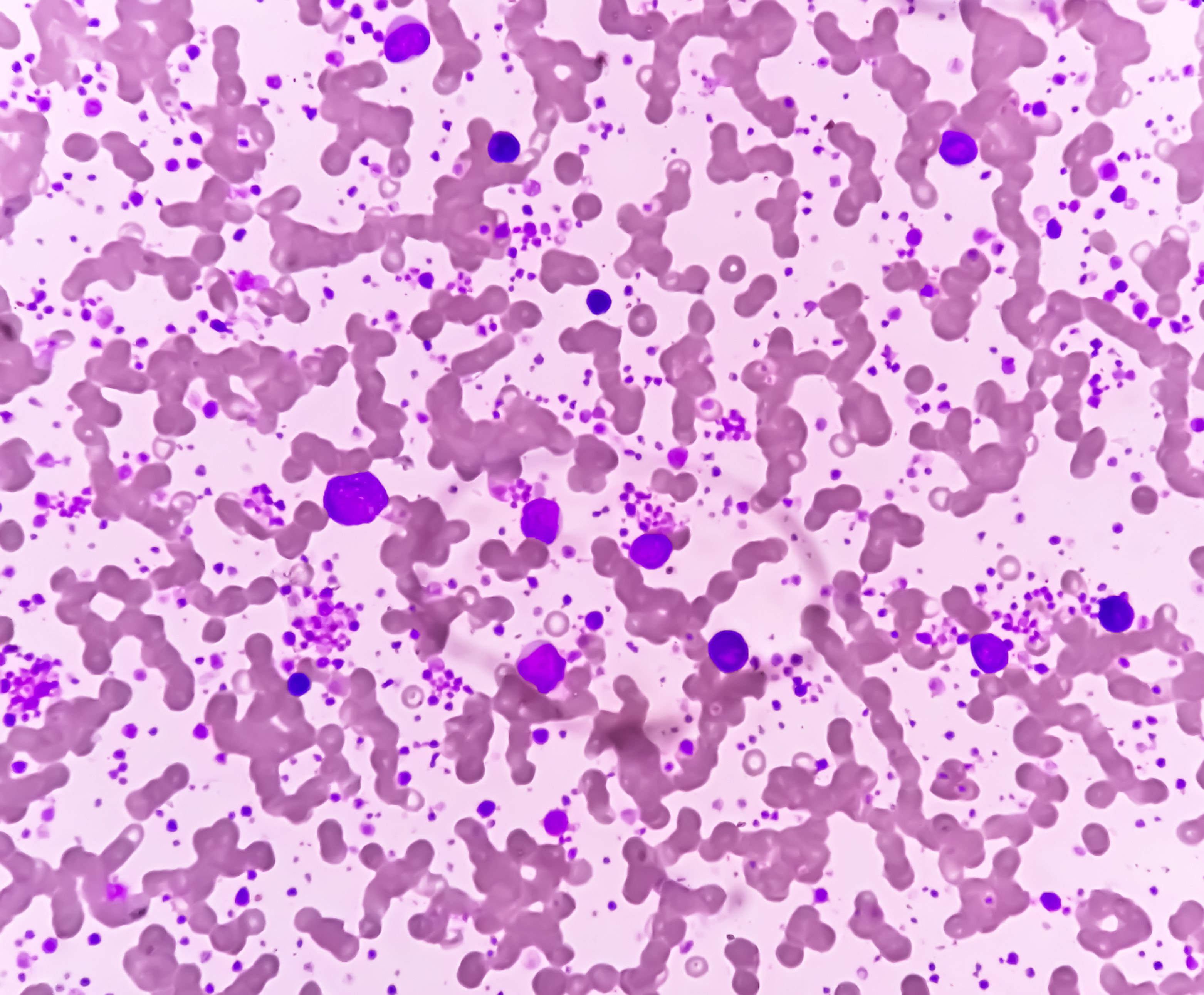Pirtobrutinib Decreased the Emergence of BTK C481 Clones in Patients With CLL
Findings from the phase 1/2 BRUIN trial of show a distinct genetic evolution in patients with B-cell malignancies. However, the baseline BTK mutations did not impede pirtobrutinib’s effectiveness.
Leukemia : © Saiful52 - stock.adobe.com

Patients with chronic lymphocytic leukemia (CLL) who progressed after treatment with the non-covalent Bruton tyrosine kinase inhibitor (BTKi), pirtobrutinib (Jaypirca), showed clearance of BTK cysteine 481 (C481) clones and the development of non-C481 clones, specifically the gatekeeper T474 and kinase-impaired L528W mutations, and other less common mutations. Investigators reported an objective response rate (ORR) of 80% (95% CI, 65.7%-89.8%). Data from the study (NCT03740529) were presented at the 2023 International Workshop on Chronic Lymphocytic Leukemia (iwCLL 2023) held in Boston, Massachusetts, on October 6 to 9, in-person and virtually.1
“Many patients discontinue covalent BTK inhibitors for either progression or intolerance,” investigators wrote in the poster. BTK C481 substitution is known to contribute to covalent BTKi acquired resistance for patients treated with ibrutinib (Imbruvica), acalabrutinib (Calquence), and zanubrutinib (Brukinsa). Pirtobrutinib uses a different BTK binding mechanism that may provide benefit in this covalent BTKi resistant population. Acquired mutations have been identified in a limited number of patients treated with pirtobrutinib” investigators wrote.
Findings from the phase 1/2 BRUIN trial (NCT03740529)2 show a distinct genetic evolution in patients with B-cell malignancies. However, the baseline BTK mutations did not impede pirtobrutinib’s effectiveness. These observations highlight the resistance mechanisms allowing for alternative potential treatment paths, tailored CLL therapies, or earlier use of pirtobrutinib in treatment protocols.
Investigators found that out of 279 patients, 49 patients had previously received a covalent BTK-inhibitor (cBTKi) and then switched to pirtobrutinib. This was determined through next generation sequencing at baseline and at disease progression. The patient median age was 69 years (range, 36-86) and the median number of prior lines was 4 (range, 1-10). Due to disease progression, 41 of the 49 patients (84%) had discontinued the prior cBKTi having received one or more of ibrutinib (n = 44, 90%), acalabrutinib (n = 10, 20%), or zanubrutinib (n = 1, 2%).
At the onset of the study, the most common genetic changes found cells were BTK (51%), TP53 (49%), ATM (27%), NOTCH1 (20%), SF3B1 (18%), and PLCG2 (10%). Out of 49 patients, 35 patients (71%) had developed at least one BTK mutation at the start of the study: C481S (23 patients), C481R (4 patients), C481Y (2 patients), C481F (1 patient), and T474I (1 patient). In the 35 patients, a total of 82 newly acquired mutations were found.
At time of disease progression, 92% of the BTK mutation C481 decreased or was eradicated and 35 out of 49 patients (71%) developed new genetic mutations and 55% (27 out of 49 patients) developed a BTK mutation. Among these 27 patients, investigators identified 36 newly acquired BTK mutations.
The most common found were gatekeeper mutations T474I/F/L/Y (35%), then kinase-impaired mutations L528W (18%), and other unknown variants near ATP-binding pocket of the BTK protein. Regardless of acquired BTK mutation, the ORR across these groups was similar: AII showed 31 out of 36 mutations with an ORR or 86%, BTK C481 was 23/25 with an ORR of 92%; BTK T474 was 16/18 was an ORR of 89%; BTK L528 was 8/9 with an ORR of 89%, and lastly BTK other was 5 out of 6 with an ORR of 83%.
Patients that had acquired the non-C481 BTK at disease progression responded similarly to pirtobruntinib with 6 out of 8 showing an ORR of 75% (95%CI, 35-97) at the median time 11.2 months, range (3.9-14.5). These patients were among those that received ibrutinib (n = 4), acalabrutinib (n = 3), and ibrutinib + acalabrutinib (n = 1) prior to pirtobruntinib.
Unlike cBTKi treatments that form lasting bonds with their target, pirtobrutinib stabilizes and encloses BTK forming it into an inactive conformation that does not allow for cellular process and prevents upstream kinases and phosphorylation of Y551. The process acts like a disruptor to the scaffolding interactions that support kinase-independent BTK.
Investigators observed that various non-C481 BTK mutations were already present in small quantities before the start of the study. This signifies that their emergence was during previous treatments with cBTKi. Both the baseline and acquired mutations in the kinase domain of BTK did not hinder the effectiveness of pirtobrutinib, highlighting the potential of pirtobrutinib as a second treatment option even for patients with existing BTK mutations.
“Approximately half of patients did not acquire BTK mutations and 29% did not acquire any mutations in this targeted panel, suggesting alternate resistance mechanisms. Several non-C481 BTK mutations were shown to be pre-existing at baseline at low variant allele frequency, suggesting emergence on prior cBTKi. Importantly, these baseline and acquired kinase domain BTK mutations did not preclude pirtobrutinib's efficacy,” investigators wrote in the poster.
References
Brown JR, Desikan SP, Nguyen B, et al. Genomic evolution and resistance to pirtobrutinib in covalent BTK-Inhibitor pre-treated chronic lymphocytic leukemia patients: results from the phase I/II BRUIN study. Presented at: 2023 International Workshop on Chronic Lymphocytic Leukemia; October 6-9, 2023; Boston, Massachusetts. Abstract ID:1548587
Mato AR, Shah NN, Jurczak W, et al. Pirtobrutinib in relapsed or refractory B-cell malignancies (BRUIN): a phase 1/2 study. Lancet. 2021;397(10277):892-901. doi:10.1016/S0140-6736(21)00224-5
Selection of Next-Gen BTK in CLL Limited By Lack of Direct Comparison
February 4th 2025During a Case-Based Roundtable® event, Nakhle Saba, MD, and participants discussed the data supporting the 2 newer BTK inhibitor therapies acalabrutinib and zanubrutinib in patients with chronic lymphocytic leukemia who received 1 prior line of therapy in the second article of a 2-part series.
Read More